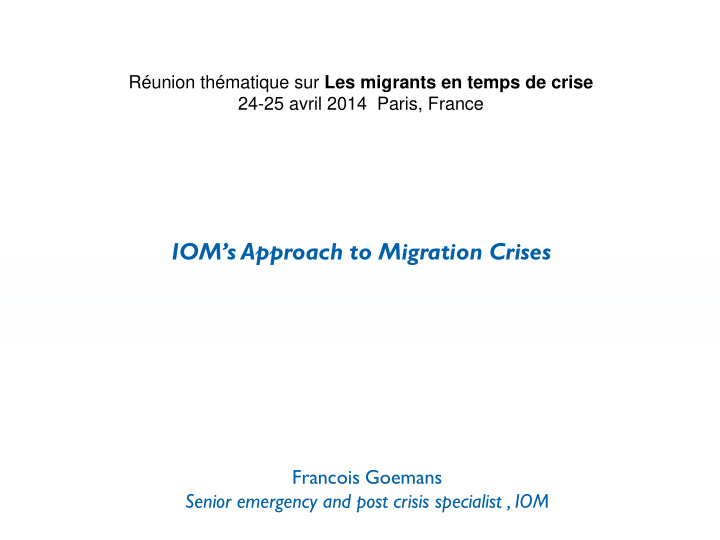



Réunion thématique sur Les migrants en temps de crise 24-25 avril 2014 Paris, France IOM’s Approach to Migration Crises Francois Goemans Senior emergency and post crisis specialist , IOM
Identifying Gaps and Improving Responses Identification of operational “gaps” or “challenges” to the provision of adequate assistance and protection to all those affected by a crisis. 6 key gaps: Crises that lead to the cross- Crises with complex patterns of International migrants border movement of internal mobility with long- caught in crisis situations in a persons that are not de jure or de term consequences on recovery, country of destination or transit facto covered under international peace, security, and development protection Other gaps within the system-wide Crises placing stress on approaches to crises, include lack migration management Crisis situations that leave of inclusion of migration countries of origin systems (need for humanitarian dynamics into broader confronted with mass border management; emergency preparedness efforts and consular assistance; robust referral returns and its long-term lack of a sector for mechanisms; or proactive protection consequences measures against trafficking in emergency transport as a persons) life saving measure
Develop an Operational Framework: Basis of the “Migration Crisis” concept framework International legal framework 3 Phases of a Crisis (before, during, and after) Structure of the framework IOM’s 15 Sectors of Assistance Linkages and coordination between IOM and the broader response system IOM Council “Encourages Member States to utilize MCOF to enhance Resolution 1243: their own preparedness and response capacity to migration crises, with support from IOM”
3 Phases of a Crisis: Operational response cycle
Diagram of Sudden Onset Natural Disaster: Critical Internal and Cross Border Movement Important Recommended SYSTEMS Cluster System (OCHA) Refugee Regime( UNHCR) Development Actors (UNDP) Security and Peacebuilding Actors CLUSTERS Camp Coordination & Camp Management Water, Sanitation and Hygiene Early Recovery Education Protection Logistics Emergency Telecommunications Health Food Security Shelter OTHER CLUSTERS/SECTORS/GROUPS Housing, Land and Property Rights Gender-based Violence Coordination Rule of Law and Justice Mental Health & Psychosocial Support Safety and Security Environment Child Protection Agriculture
Migration Crisis Operational Framework: Goals and objectives T o improve T o support IOM’s response Member States as the agency on understanding mandated to look and addressing at all migration mobility aspects related issues comprehensively T o complement existing response systems by identifying gaps and providing solutions To better assist and protect vulnerable mobile populations, ultimately upholding their human rights and dignity
Central African Republic Multiple displacement dynamics
TCNs and returnees: regional impact 94,909 16,885
CHAD Main Entry Points N’DJAMENA DOBA Arrived 6,681 Arrived 16,742 Departed 292 Departed 10.900 Left in TCs 6,435 Left in TCs 5,842 Doyoba TC Doba MOUNDOU SARH (DOYOBA) TC EP Sido Arrived 3,536 Arrived 13,079 EP Gore Departed 2,068 Departed 1,377 EP Mbitoye Left in TCs 1,468 Left in TCs 11,517 EP GORE SIDO Arrived 7,453 Arrived 16,173 Departed 432 Departed 6,011 Left in TCs 7,021 Left in TCs 10,162 MBITOYE Arrived 13,734 Departed 142 Total N’Djamena South Left in TCs 13,592 Registered 77,398 16,742 60,656 Transport by IOM 16,683 6,361 10,322 Remaining in TCs 56,037 5,842 50,195
CHAD Final Destination as expressed by the evacuees Main Final Return High Impact Areas Destinations Sido 22-Feb-14
Merci
Recommend
More recommend